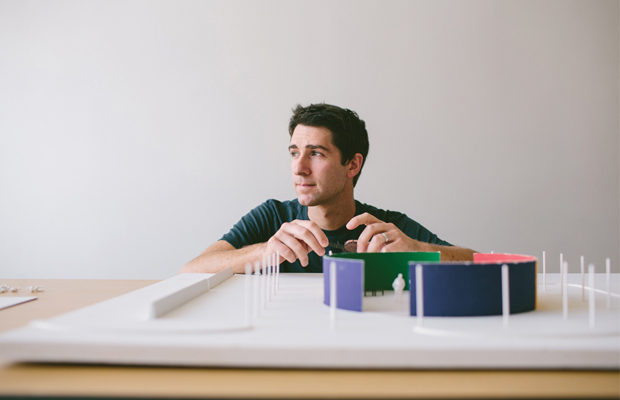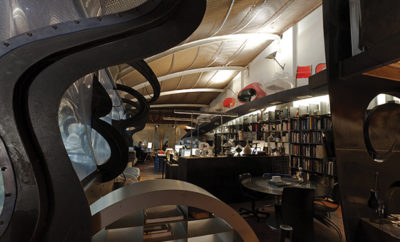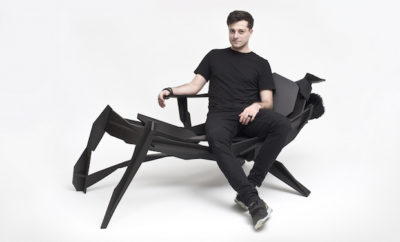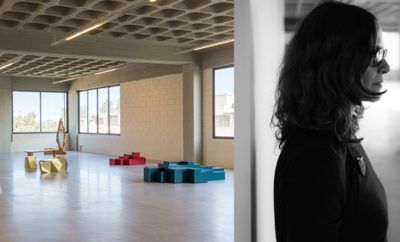 Jonathan Muecke with his mock-up for the 2014 Design Miami entrance pavilion.
Jonathan Muecke with his mock-up for the 2014 Design Miami entrance pavilion.
Design
Twilight Zone: The Engaging and Almost Inexplicable Jonathan Muecke
GIVEN THE EXCESSES OF THE CONTEMPORARY design world, Jonathan Muecke’s practice is at once spare and complex. His elegant but idiosyncratic objects reside respectfully at the edge of, if not beyond, the accustomed bandwidth of contemporary design. Although functional, they inhabit an independent realm of design thinking that holds modernist traditions at bay. In fact, Muecke’s cerebral and experimental practice seems more aligned with that of a fine artist than an industrial designer, calling to mind the conceptual practices of such twentieth-century luminaries as Yves Klein, Ellsworth Kelly, and Donald Judd.
True, most of Muecke’s objects fit into typologies such as chair, stool, or table, yet they challenge received notions of how such objects should look and function. They are fabricated variously from stainless steel, aluminum, wood, fiberglass, carbon fiber, or composite materials (a favorite), and sometimes polychromed in saturated hues of blue and green. By eliminating all unessential detail, his objects question our perceptual acumen, about spatial relationships, dynamic edge, and surface plane.
Ironically, Muecke does not view his reductive objects, which have names like Painted Shape (PS) or Coiled Stool (CS), as minimalist, but rather as “maximums.” He states, “My objects must have their own potential to be other things—relational to the environment and to other objects, away and outside of me.

Muecke does not view his reductive objects as minimalist, but as “maximums.” Painted Shape (PS), seen here, was created in 2013 is an edition of twenty-four plus two artist’s proofs.
He defines his work as “Open Objects,” meaning they are to be perceived as new or unknown even when seen repeatedly. “There should be a way to let the unknown remain in the object,” he explains. “You recognize this in objects, or in moments like standing on the edge of the shore and looking into the sea. It’s about not knowing what you are looking at. It’s that, and also knowing what you are looking at. You are knowledgeable and ignorant at the same time.” For example, Low Wooden Shape (LWS) is a long bench-like form with ten legs and a center element resembling the keel of a sailboat. Made from white oak, LWS is potentially multifunctional— wide enough to be a bench in an art museum, a bed, or a place to stack books. Or a sculpture.
Particularly intriguing is Mezzanine. An oval-shaped table fabricated from aluminum, its five regularly spaced legs are not on any type of axis. Moreover, the pattern within the table’s edge shifts five times, but not in correspondence with the legs. Why Mezzanine? “A mezzanine is a free architectural space; it floats in between,” Muecke says. “Above the ceiling is a floor and below the floor is a ceiling.”
Muecke’s recently completed Blue Cabinet (BC), a high-walled isosceles triangle painted a near Yves Klein blue, is equally confounding. Each side slides open on a track. However BC has no top, floor, or internal shelving and, when closed, suggests a 1970s minimalist sculpture more than a storage container. “A cabinet defines two separate things—interior and exterior. With BC I want to push the notions, the limits of what a cabinet needs to be or have,” he says.

Muecke recently completed Blue Cabinet (BC), each side of which slides open, though the piece doesn’t really function as a cabinet at all.
Muecke clarifies that his practice is not “about design to make something.” Rather, his objects suggest a range of functions. “I am interested in making something into something else—the in between spaces,” he says. “I want them free of fixed relationships with regard to color, size, material, or texture, or with the things around them.” Significantly he wants all elements emphasized equally. “I am successful when these traits become equalized and you can’t distinguish between them. When the shape is the color, or the scale is the material.”
This singular aesthetic informs his labor-intensive process, self-described as a field of electrons moving around all at the same time. “Everything is in play all at once. You are thinking through all options and possibilities simultaneously—color, shape, typology, texture, scale, materials. Where does this ‘belong’ is a false question; rather, I want to make an object that can be everywhere.”
Increasingly, Muecke’s objects are garnering acclaim. His work has been collected by the Museum of Arts and Design in New York City and the Philadelphia Museum of Art. Recently he was tapped by Design Miami to create the fair’s 2014 entrance pavilion, a project usually awarded to an architectural office.

Although scale has long been critical to Muecke’s practice, the Design Miami project has allowed him to scale up for the first time. “It has always been my ambition to work at this scale, so this project has been a welcome challenge,” he says. Defining the project as neither big nor small, Muecke channels a statement by sculptor Tony Smith: “To be in between is the right scale.”
The project comprises two curved, rolled steelplate walls that form a circle forty-five feet in diameter, with space between them to form openings for entry. At ten feet high and sixty-one feet long, the exterior of each wall is painted with equal sections of blue and yellow, while the interior of one wall is red and the other green. The steel edges of the openings will be honed extremely thin. “There will be no way to tell how thick the wall is by looking at the edge,” Muecke explains. “The project will take away architecture’s third-dimension. It will eliminate any fixed notion of architecture.” His goal, again, has been to hold in balance—to equalize—material, color, and scale.

Among the works seen in this view of Muecke’s old studio are Field, 2010, in carbon fiber and epoxy (leaning against the wall); and stacks of Woven Chair (WC) prototypes, also of 2010 in carbon fiber and epoxy. Muecke wouldn’t reveal what’s under the foil. Travis Roozée photo.
At thirty-one, Muecke is tall, lean, and understated, without superfluous detail in either his manner or dress. His speech is restrained but alert, and he is exceedingly articulate. That the listener does not always follow his thinking—whether about his unorthodox forms, composite materials, or strenuous process—seems not to annoy him. Rather, he is patient enough to retrace his complex ideas, drawing on a tablet for clarification.
Muecke, who was born in Cody, Wyoming, resides in Saint Paul, Minnesota, where he maintains a small storefront studio for conceptualizing projects and meetings. He graduated in 2006 with a degree in architecture from Iowa State University in Ames. In 2007 he worked for a year for Herzog and de Meuron in Basel, Switzerland. Why didn’t he stay when offered the opportunity? “The experience was so good, I thought I should carry it on to something else,” he answers. In 2010 he graduated from the Cranbrook Academy of Art with an MFA in design and moved to the Twin Cities. He is a member of Fourth Street Guild Furniture Makers in Minneapolis, where he has a dedicated workspace to test materials and transmute his ideas into full-scale prototypes or fully realized objects.

The artist at work on his Coiled Stool (CS), 2013, and the finished stool, made out of carbon fiber, Kevlar, and epoxy
In the end, Muecke’s Open Objects suggest the reification of Japanese haiku in their juxtaposition of elements, their spare presentation, and their deep knowledge of form and perception. To contemplate one of Muecke’s objects is to comprehend the act of seeing. Perhaps most revealing, Muecke mentions a 1963 declaration by composer and conceptual artist George Brecht titled “Exercise”:
Determine the limits of an object or event.
Determine the limits more precisely.
Repeat, until further precision is impossible.
[Photos are courtesy of Design Miami and Volume Gallery]












